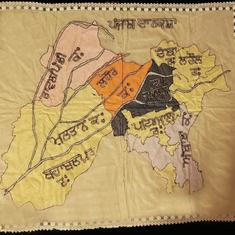The Shiv Sena may have been a no-show at Kasuri’s book launch, but its threats have always been taken seriously. Just last week, organisers of Pakistani ghazal singer Ghulam Ali’s concerts cancelled his shows in both Mumbai and Pune after the Sena warned of violence.
The Shiv Sena has always been sore about allowing cultural ties with Pakistan at time when the Kashmir border is tense. Twice – in 1991 and in 1999 – Shiv Sainiks forcibly cancelled India-Pakistan cricket matches by damaging pitches in Mumbai and Delhi. Five years ago, they also attacked the screenings of Shah Rukh Khan films after the actor voiced support for allowing Pakistani players in the Indian Premier League.
Pakistan, however, is just one of the Shiv Sena’s targets in its bid to stay politically relevant. The outfit’s history of using aggressive violence to assert itself has a long history that dates back to its very origins, before the Sena became a political party.
Against South Indians
The Shiv Sena was founded in 1966, three years after Bal Thackeray – a cartoonist and editor of satirical Marathi weekly magazine Marmik – began publishing lists of all the non-Maharashtrians heading major companies in Mumbai. He named this weekly column “Read and Rise”, in a bid to stir popular sentiment against people from “outside” depriving Marathi speakers of jobs and opportunities.
The first target of this “sons of the soil” rhetoric were south Indians, or “Madrasis”, as Thackeray pejoratively called them. On October 30, 1966, Thackeray gave a fiery speech at his first Dussera rally in Shivaji Park (now an annual tradition), after which incensed Sena workers pelted stones at Udupi restaurants on their way out. Such attacks were to become part of the Sena's standard repertoire.
According to Vaibhav Purandare’s book, The Sena Story, Shiv Sainiks often “barged into various offices, gheraoed top officers, delivered physical blows to ‘lungiwallahs’ and ‘bhaiyas’ who had ‘robbed’ their jobs, attacked Udipi hotels and did their utmost to hold the ‘unjust, exploitative and discriminating’ governmental apparatus to ransom”.
In the 2000s, Biharis became a specific new target for the Shiv Sena as well as its breakaway faction, Maharashtra Navnirman Sena. Members of both parties routinely inflicted violence on Mumbai residents from Bihar, particularly auto and taxi drivers and students.
Early years of communalism
In 1966, the Sena’s chief raison d’être was protecting Maharashtrian interests in Mumbai’s diverse economy. It didn’t take long, however, for Thackeray to incorporate an anti-Muslim, Hindutva stance within the fold of the Sena ideology.
In 1967, communal tensions arose in Kalyan over a shrine called Durgadi Fort, on which both Hindus and Muslims had claims. Muslim residents had taken to praying namaz at a spot near the shrine, and Thackeray announced that on September 8 that year, the Sena would hoist a saffron flag and perform a religious ceremony within the shrine. The police retaliated by announcing a ban on assembly in that area, but Shiv Sena workers went ahead and defied the ban, gathering at the spot to pray.
In 1970, the Sena perpetrated similar communal riots in the Muslim-dominated town of Bhiwandi, on the outskirts of Mumbai. In this town, tensions between the two communities were already high when the Sena decided to take a Shivaji Jayanti procession through the Muslim localities. This led to rioting between Hindus and Muslims in which more than 250 people were killed.
The Sena’s best-known case of being the force behind communal riots is that of the Hindu-Muslim riots in Mumbai in 1992-'93. The Srikrishna Commission, which inquired into the bloodbath, named the Sena as the outfit responsible for orchestrating the violence against Muslims, who formed the majority of the 900 people who died in the riots.
Border dispute, not in Kashmir
Much before the riots of 1992, the Sena had held Mumbai ransom in February 1969 over the Maharashtra-Karnataka border dispute. When deputy prime minister Morarji Desai visited Mumbai, Sena workers aimed to stop his car so that they could talk to him about the plight of Marathi-speaking people in Belgaum and other districts of north Karnataka. Thousands of Sainiks had assembled along Desai’s route, and despite tight police security, a few of them managed to jump in front of the vehicle.
The car, however, attempted to speed away, injuring some Sena workers. In what came to be characteristic of the Sena, its workers reacted by smashing the car windshield and going on a rampage in the city – stones were pelted, buses, shops and restaurants were set ablaze and 59 people died in police firing. The anger had intensified after the police arrested Bal Thackeray, and it didn’t slow down till the Sena leader himself appealed for calm from jail.
Communists and Dalits
The Communist Party of India – a strong influence in Maharashtra politics in the 1960s – was another favourite target for the Shiv Sena in its early years. Shiv Sainiks once disguised their way into a rally by progressive writer Acharya Atre by carrying red flags, but as soon as Atre began to speak, they began to throw a volley of slippers at him. According to Purandare’s book, Atre was forced to take shelter in a nearby hospital while his car was smashed.
In 1970, the Sena’s anti-communism sentiment reached new heights as CPI leader Krishna Desai was stabbed to death. Seven Sainiks were initially arrested and 16 were eventually convicted. Thackeray had allegedly congratulated those who committed the murder, but he was never implicated in the case.










